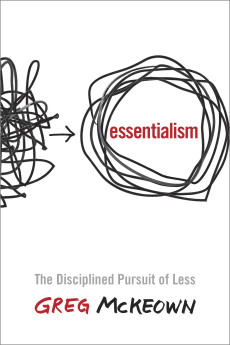I first learned the idea of the fear of missing out when I attended the GSB. It was a funny problem: there are so many good things happening here you will constantly be thinking about all the other things you could be doing. But what I have found is that the effect goes way beyond business school to affect the survival of companies and the quality of life otherwise successful people have.
For 15 years I have been pretty obsessed with a single question: “Why is it that capable people (and teams) don’t break through to the next level?” The answer, to my great surprise, is success.
I first saw this phenomenon in working with executive teams in Silicon Valley. When they were focused on what was essential it led to success. But success comes with so many options and opportunities that it can undermine the very focus that led to success in the first place. So, exaggerating the point in order to make success can become a catalyst for failure. It leads to what Jim Collins called “the undisciplined pursuit of more.” The antidote is the disciplined pursuit of less (but better). But to even begin that journey we need space to think about what we should be focused on at all. As someone once said to me, “Oh Greg, I am too busy living to think about life!” That mantra comes at a cost because it increases the chance that we will be tricked by the trivial. Below is an excerpt from my recent book, Essentialism: The Disciplined Pursuit of Less, which addresses this specific challenge.
Before you can evaluate what is and isn’t essential, you first need to explore your options. While Nonessentialists automatically react to the latest idea, jump on the latest opportunity, or respond to the latest e-mail, Essentialists choose to create the space to explore and ponder.
Space to Design

The value of creating space to explore has been emphasized for me in my work with the d.school at Stanford (officially the Hasso Plattner Institute of Design at Stanford). The first thing I noticed when I walked into the room where I had been asked to teach a course was the lack of traditional chairs. Instead there are foam cubes you can sit on—rather uncomfortably, as I soon discovered. Like almost everything at the d.school, this is done by design. In this case the cubes are there so that after a few minutes of uncomfortable perching students would rather stand up, walk around, and engage with one another—not just the classmates sitting to their right or to their left. And that is the point. The school has used the physical space to encourage new ways of engaging and thinking.
To that end, the school has also created a hiding place called “Booth Noir.” This is a small room deliberately designed to fit only one to three people. It is windowless, soundproof, and deliberately free of distraction. It is, according to Scott Doorley and Scott Witthoft in their book Make Space, “beyond low-tech. It’s no tech.” It’s tucked away on the ground floor. It is not, as Doorley and Witthoft point out, on the way to anywhere else.2 The only reason you go there is to think. By creating space to think and focus, students can step back to see more clearly.
For some reason there is a false association with the word focus. As with choice, people tend to think of focus as a thing. Yes, focus is something we have. But focus is also something we do.
When I say focus, I don’t mean simply picking a question or possibility and thinking about it obsessively. I mean creating the space to explore one hundred questions and possibilities. An Essentialist focuses the way our eyes focus; not by fixating on something but by constantly adjusting and adapting to the field of vision.
In order to have focus we need to escape to focus.
On a recent meeting back at the d.school (in another room with no seats or desks but with whiteboards from floor to ceiling covered with Post-its of every fathomable color), I met with Jeremy Utley. He is my partner in developing a new prototyped class that, in a moment of genius, Jeremy dubbed “Designing Life, Essentially.”
The sole purpose of the class is to create space for students to design their lives. Each week it gives them a scheduled excuse to think. They are forced to turn off their laptops and smartphones and instead to turn on the full power of their minds. They are given assignments to practice deliberately discerning the essential few from the many good. You don’t have to be at the d.school to practice these habits. We can all learn to create more space in our lives.
Reprinted from the book Essentialism: The Disciplined Pursuit of Less by Greg McKeown. Copyright 2014 by Greg McKeown. Published by Crown Business, an imprint of the Crown Publishing Group, a division of Random House LLC, a Penguin Random House Company.


